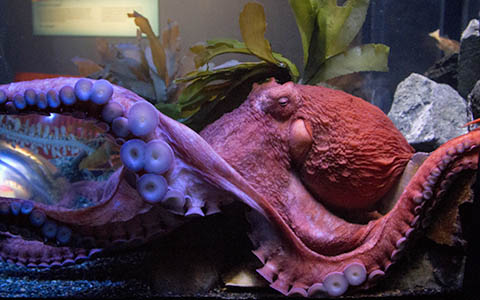Giant Pacific octopuses are amazing animals. They’ve got skills and abilities that could make anyone jealous. Read on to learn eight facts about the giant Pacific octopus that just might leave you wishing you had a few more of these amazing attributes.

Giant Pacific octopuses are flexible, strong and very intelligent. You can learn much more about them during Octopalooza from February 13-22 at Aquarium of the Bay. Aquarium of the Bay/Courtney Lauchaire
By Mallory Johnson
Published: February, 2015
Giant Pacific octopuses are amazing animals. They’ve got skills and abilities that could make anyone jealous. Read on to learn eight facts about the giant Pacific octopus that just might leave you wishing you had a few more of these amazing attributes.
Flexibility: No stretching needed here. Giant Pacific octopuses are naturally very flexible. With no skeleton to get in the way, a giant Pacific octopus can move its body in any number of ways and can squeeze into incredibly small spaces.
Super strength: No more relying on someone else to help you open that jar of pickles. If you’re a giant Pacific octopus, you’ve got this covered. Weighing in at an average of 50 pounds, giant Pacific octopuses exhibit great feats of strength. When using all eight arms, the giant Pacific octopus can move more than 700 pounds. That’s 14 times its own weight!
Camouflage skills: Have you ever had a moment where you wanted to disappear? If you’re an octopus, you can be as good as gone in a matter of seconds. Giant Pacific octopuses have amazing camouflage skills that help them blend in with any environment. They can change the color of their skin within a fraction of a second. Not only that, these cunning creatures can manipulate their muscles to change the texture of their skin as well.
Intelligence: Giant Pacific octopuses are considered the most intelligent of all invertebrates. Finding their way through mazes, problem solving and unscrewing jar lids are just some of an octopus’ many talents.
They’ve got a lot of heart: There’s no lack of love for an octopus. They have three hearts! Two hearts work to move blood beyond their gills, while the third heart keeps circulation flowing for the organs.
Natural self-defense: Octopuses come readily equipped with cephalopod ink, a dark liquid ideal for evading predators. When threatened, the octopus will shoot out a smokescreen that can take the shape of an octopus, providing a diversion that allows the real octopus to escape.
They can walk on land: Okay, so we can do this too, but don’t act like you’re not impressed! While the phenomenon is not commonly observed, octopuses have been known to climb out of the water and pull themselves across rocks to reach tidal pools, using their muscular arms and suckers to pull themselves across the terrain.
They feast on crab: Not unlike many of us, a favorite food of the giant Pacific octopus is the Dungeness crab. With their ability to squeeze into small spaces, many octopuses tend to find themselves in crab nets, surrounded by their favorite tasty food. This explains why crab fishermen will often pull up their traps to find an octopus inside that has eaten all of their catch. Instead of returning the octopus back to the ocean where it will continue to eat their catch, many fishermen will respond by eliminating the competition. In 2005, Aquarium of the Bay started a program asking fishermen to help these octopuses that unintentionally find themselves in the wrong place at the wrong time. Aquarium of the Bay takes these bycatch animals, offering the octopuses a safe new home with plenty of delicious (and sustainable) crab.
Learn more about this eight-armed wonder from February 13-22 at Aquarium of the Bay during Octopalooza, a whole week of amazing octopus facts, fun activities and more. Find out more about giant Pacific octopuses and Octopalooza at www.aquariumofthebay.org.
Mallory Johnson is the Public Relations Coordinator for Aquarium of the Bay, a nonprofit organization dedicated to protecting, restoring and inspiring the conservation of San Francisco Bay and its watershed.

